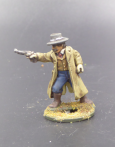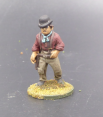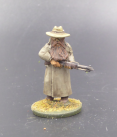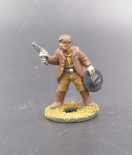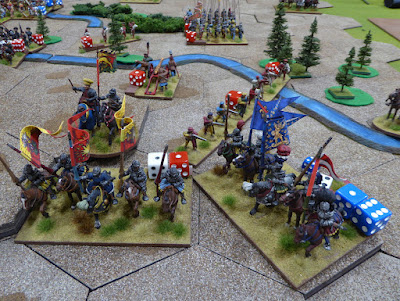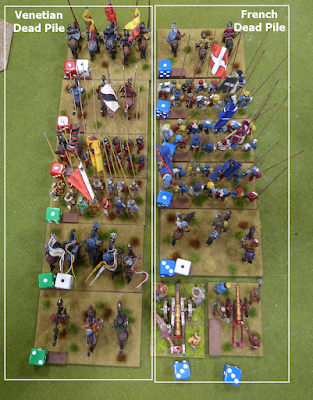After seeing the above book mentioned on Peter's blog (see A New Book...) and listening to the authors' podcasts, I placed an order. Book arrived quickly and was read just as quickly. I won't repeat the contents of the book since Peter did that and Table of Contents can be seen on Amazon.
What I do want to discuss is the authors' wrestling with the renaming of the gaming aspect of the hobby that we enjoy. Many of us likely refer to this hobby as miniatures wargaming or playing a miniatures game. Really, I lump all facets of the hobby simply into the catch-all, wargaming.
The authors' take a different tack, however. They state their rationale for first dismissing the use of tabletop games, then dismissing miniatures games, then dismissing miniatures wargames, before settling onto the term of non-discrete miniatures games.
The name, non-discrete miniatures game is chosen since the authors argue that,
- Games are not necessarily about war.
- Spatial relationships between miniatures and terrain are crucial.
- Any physical object can be introduced into the game and have meaning in game terms (non-discrete components).
- Movement and positioning are not limited to fixed increments or grid spaces (non-discrete positioning).
Non-discrete is an interesting term to choose and returns me to the days of studying mathematics. Typically, one sees a bifurcation between discrete and continuous but not between discrete and non-discrete. I suppose if the term, continuous was utilized as in continuous miniatures game, readers might conclude that we game non-stop!
Moving on, the authors define these games by their unique spatial characteristics in that,
- Precise physical positioning matters. That is, movement and placement are analog (and continuous) and not grid-based.
- Players can bring any object to the game table and game systems must accommodate an infinite variability of components.
One example given of discrete movement and figure (marker) placement is the game of Monopoly. A playing piece can only be in one of the grid spaces on the playing board at any one time and not between two spaces. In a non-discrete game, movement is governed by a measuring device with a miniature able to move anywhere along that vector and stop anywhere short of the maximum move distance allowed. This non-discrete movement criterion seems to not only explicitly exclude grid-based games from inclusion into non-discrete miniatures game by definition but implicitly as well with the continuous nature of measured movement along a vector.
In later chapters, the authors relax the condition for non-griddedness. Games having gridded movement or zoned movement may fit into the structure of building a non-discrete miniatures game as long as the focus on the design remains on the spatial relationships within the game and the infinite variety of components. Given that discrete positioning and movement criteria are later relaxed, the grid vs non-grid distinction should be dropped from the definition altogether.
With the argument for excluding gridded games jettisoned, what remains the focus of non-discrete miniatures gaming? What remains constant is the reliance upon the external components brought into the game system.
What distinguishes many boxed miniatures games from the non-discrete miniatures games that the authors describe? The difference is that the former is self-contained with the rules and all of the components necessary for play while the latter is similar to a toolkit with a programmed game engine requiring any number of external inputs provided by the player(s). These external inputs could include figures, terrain, army lists, dice, measuring devices, etc.
Is the classification still between discrete vs non-discrete miniatures games or is a better fitting distinction between endogenous vs exogenous miniatures games? I suggest that the latter terminology may be a better fit if one agrees with the authors that the deciding attribute is bringing external inputs into the system. Still, it is all wargaming to me.
There is much more to be pulled from this book of interest to wargamers and wargame designers whether focusing on non-discrete miniatures gaming or not. I have only brought up the main thesis of Chapter 1! With so much to consider, I may non-discretely dip back into this text on occasion.












